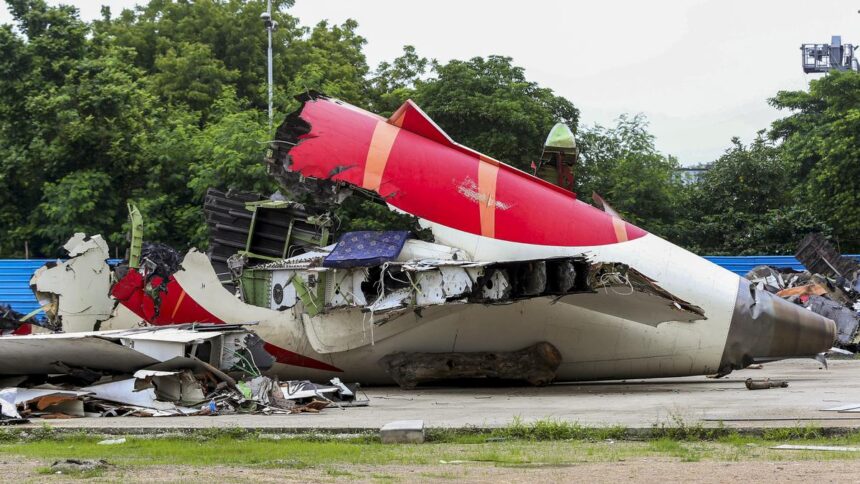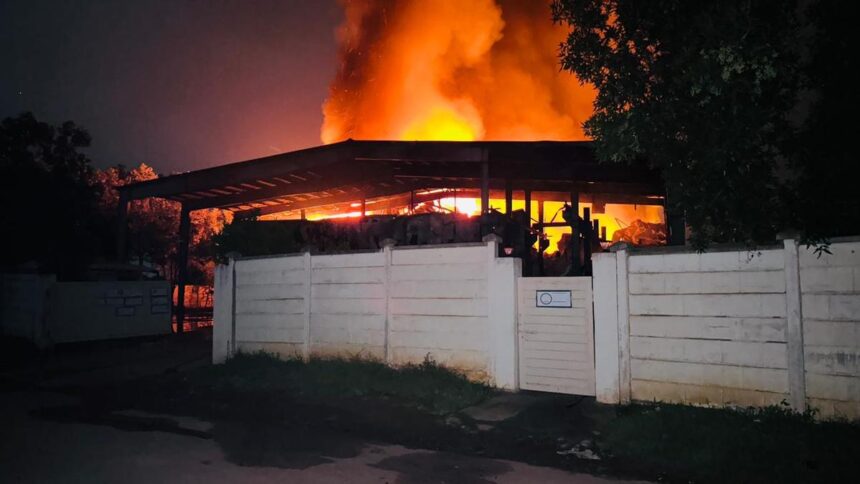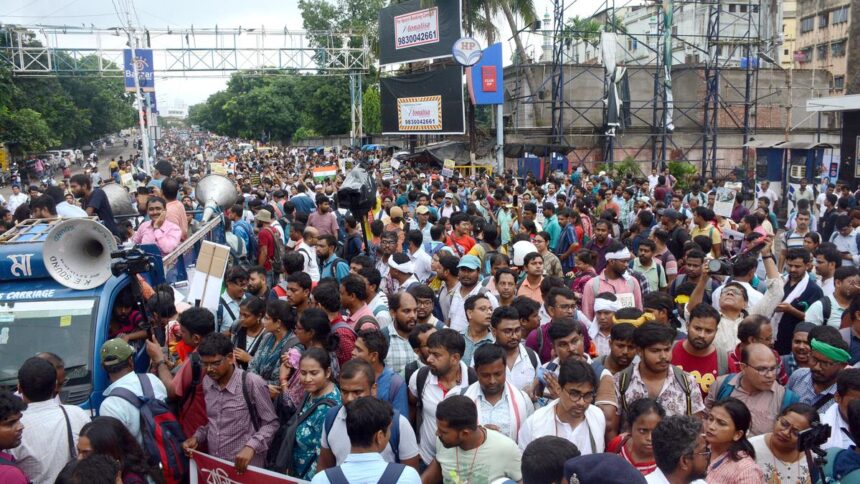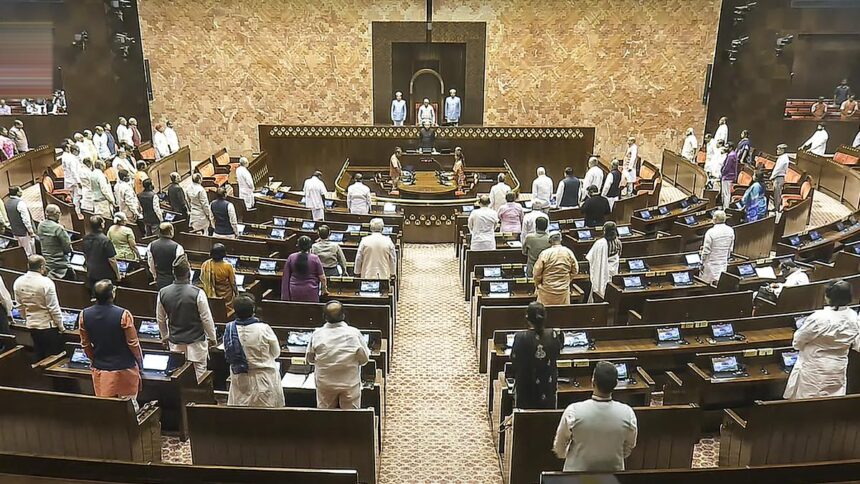The morning of July 2 dawned under a stubborn drizzle, the kind that clung to skin and silence alike. Outside the scorched ruins of Sigachi Industries, 35-year-old Savreen Parbin stood beneath a tree near the factory’s main gate, her dupatta soaked, her hands clutching a mobile phone and an Aadhaar card. They belonged to her husband, Tasallimuddin Ansari. The last things she would carry back home to her children.
Just days earlier, the 40-year-old contract worker from Dawa village of Bihar’s Bhojpur district had become a permanent employee at the chemical factory in Telangana’s Sangareddy district, earning a monthly salary of ₹20,000 after three years on the job.
On the morning of June 30, he had joined over 140 workers for duty and by 9 a.m., he was one of 44 confirmed dead. His body was buried under the debris of a collapsed G+1 production shed, that came down by a deafening blast that shook the town and shattered families.
“He had called me at 7.20 a.m.,” recalls Parbin, her voice barely rising above the mist that hung thick with the faint stench of ammonia.
“He was walking to work then. I didn’t tell our children about the blast. I flew down to Hyderabad alone. They kept asking if I was bringing their father back home,” she adds, sobbing.
Now, drenched in the drizzle, she waited, like dozens of others, for a name, a body, an answer.
Inside the factory compound, 47 kilometres from Hyderabad, rescue teams picked through blackened rubble and chemical fumes that grew more suffocating with each step toward the gate. The explosion had turned a workplace into a death trap, leaving families to scan morgue lists and hoping against hope for a miracle.
The Sigachi unit sits in the heart of an industrial belt dense with chemical, plastic and pharmaceutical factories. A petrol station is barely 700 metres away. Three schools, including the Zilla Parishad High School and Telangana Minorities Residential School for Boys, lie within a 2.5-km radius.
Rescue efforts had dragged through the previous night, slowed by downpour and debris. By the morning of July 2, the skies were still weeping. So were the people outside Sigachi.
As of July 10, a total of 44 workers were confirmed dead and over 30 injured. According to Sangareddy District Collector P. Pravinya, the identification process was harrowing; some bodies were so mangled they required DNA testing. She says the eight missing men cannot be declared as deceased yet.
“They are officially listed as ‘missing’ in the district records. None of the DNA samples have matched with them. We have counselled the families of the eight about this situation. A report stating the same is being sent to the government,” she informs.
A factory in ruins, a town in shock
Around 9 a.m. on June 30, a massive explosion ripped through the Pashamylaram industrial estate. The production shed at Sigachi Industries where microcrystalline cellulose (MCC) was manufactured had crumbled like a sandcastle, leaving behind a wasteland of scorched concrete and twisted metal. MCC, a pharmaceutical binder, is Sigachi’s flagship product. With units in both Telangana and Gujarat, the company is among India’s top manufacturers — but on this day, its reputation lay buried beneath rubble and ash.
By 9.37 a.m., the fire control room had been alerted. Fifteen fire tenders rolled in. Police, medical staff and National Disaster Response Force (NDRF) teams followed, battling flames and smoke to reach those trapped inside.
Eyewitnesses say the sound of the blast echoed for kilometres.
Inside the factory, it had shredded walls, pipelines, flesh and every semblance of order. Rescue workers moved through what seemed like a battlefield. Steel had curled like wire. Fire licked at fractured pipes. Emergency teams fought fire, smoke and falling structures as they searched for any sign of life.
Outside, panic and grief collided. A woman in dark green salwar-kameez darted between gates, screaming, “Mera beta nahi mil raha!” Her son, in his 20s, hadn’t been seen since the explosion. Around her, voices blended into a chorus of names — missing sons, brothers, husbands. A dust-covered man, reeking of chemicals, spoke of three relatives still unaccounted for: “I can’t recognise anyone. They are burnt beyond recognition.”
Revenue department officials had set up a makeshift desk at the gate, noting names, contact details, and last known sightings. “We will update you once we have clarity,” one said, eyes glued to the register.
Sai Reddy, a local youth, had arrived minutes after the blast and filmed the wreckage: a factory bus with blown-out windows, workers on the ground, motionless. “Their skin was peeling. One was unconscious. They carried him out by his limbs,” he says.
Many of the workers were migrants — from Bihar, West Bengal, Uttar Pradesh — hired for 12-hour shifts that paid around ₹750 a day. Officially, the factory followed an eight-hour shift cycle: 6 a.m. to 2 p.m., 2 p.m. to 10 p.m., and 10 p.m. to 6 a.m. But overtime was routine. Phones had to be surrendered at the gate and collected only after sign-out — a rule that, in hindsight, added a cruel layer to the search, as dozens of devices lay unanswered at the security desk.
According to district officials, 143 people were present inside the compound at the time of the blast. As of July 7, a total of 57 had been confirmed safe while 34 others were still battling injuries in hospitals across Sangareddy, Hyderabad and beyond.
“We managed to pull out about 30 men alive and rushed 25 to nearby hospitals,” shares NDRF Deputy Commander Damodar Singh.
The victims were first taken to Kakatiya Hospital, and later shifted to private facilities as the scale of injuries became clear. “Those weren’t routine burns,” says Srinivas Reddy, superintendent of Patancheru Government Hospital, located just 20 minutes from the site. “It wasn’t just the fire — the blast force tore bodies apart. Some were found in pieces.”
Sridhar Chary, head of forensics and in-charge of autopsies, describes the remains that arrived in plastic sheets. Some, he says, were no larger than a cushion: “Families came with keychains, photos… anything they thought might help us identify their loved ones. But without DNA, it was impossible to confirm.”
A preventable disaster?
The question hung in the air like the acrid fumes lingering over the ruins: Could this have been avoided?
On July 2, Telangana government announced the formation of a four-member expert panel to probe the blast. Tasked with piecing together the sequence of events, the committee would assess worker safety protocols, investigate possible violations in industrial and chemical handling, and determine whether lapses by the management led to the tragedy.
Y. Mohan Babu, Joint Chief Inspector of Factories, confirms that the inquiry is being jointly conducted with the State-appointed panel. Preliminary findings point to the dryer unit as the origin point of the blast, likely due to pressure build-up and static charge.
“It was not a reactor blast. We are reviewing the unit’s safety and maintenance records. Some observations have been made, but we will comment further once the full investigation is complete,” he explains.
District Fire Officer B. Nageswara Rao says Pashamylaram is a designated Industrial Development Area, “an IDA meant solely for factories”. “We conduct drills with locals every three months to prepare for emergencies,” he adds.
Sigachi Industries filed a notice with the stock exchange on June 30, stating that operations at the Hyderabad unit would be suspended for 90 days due to extensive damage to core manufacturing infrastructure. The filing, however, made no mention of casualties.
Two days later, the company issued a public statement dismissing reports that the blast was caused by a reactor. “We would like to clarify that the accident was not caused by a reactor explosion,” it read.
According to the statement, the company was coordinating emergency relief efforts and had announced an ex-gratia compensation of ₹1 crore per deceased worker, along with medical and rehabilitation support for the injured.
Still, the damage — physical, emotional and reputational — was already unfolding. A criminal case was filed against the company’s management. By the next trading day, Sigachi’s shares had plunged 18%, reflecting not just market anxiety, but a deeper erosion of public trust.
In the days following the explosion, the scene around Sigachi Industries remained grim. A steady drizzle fell over the shattered compound, mingling with fine grey dust kicked up by movement. Families of the missing stood silently outside, huddled under plastic sheets, waiting for names, for remains, for anything that resembled closure.
Inside the blast zone, rescue teams returned for another sweep. By July 9, they had recovered 70 human remains. Sixty-seven of them were matched to deceased workers through forensic analysis — bones like the patella, femur and fibula, found scattered across the debris. Temporary barricades were set up so that the skeletal fragments could be collected without public disruption and transferred to hospital labs for further testing.
Warnings ignored, questions remain
Each time the rain intensified, the pace of rescue operations slowed — and the patience of waiting families wore thin. Anger rippled through the community as fresh allegations surfaced. According to an FIR filed with Sangareddy police, workers had warned the management about faulty machinery. The complaint, filed by 21-year-old Sai Yashwanth, alleged that his father, Rajanala Venkat Jagan Mohan — one of the deceased — had repeatedly raised concerns about deteriorating equipment. Other workers had voiced similar fears, but the company allegedly ignored them and continued operations.
Yashwanth received the news of the explosion from his uncle around 11 a.m. that day. He rushed to Patancheru Government Hospital, only to find his father in the mortuary. “Some of the bodies were so badly burnt, they couldn’t even be recognised,” he says.
Still, not everyone knew of prior warning signs. Uday, a senior worker with nine years at the plant who narrowly escaped the blast, says: “We never felt anything was wrong with the machines. If something had seemed risky, we would have spoken up.”
The BDL Bhanur police registered a case under multiple sections of the Bharatiya Nyaya Sanhita, including culpable homicide not amounting to murder, attempt to commit culpable homicide and voluntarily causing grievous hurt.
Sangareddy Superintendent of Police Paritosh Pankaj says investigations are ongoing. “Eight workers are listed as missing. We are conducting daily searches. Expert teams are collecting factory records, equipment logs and physical evidence to probe any possible negligence or intent.”
On July 8, officials from the National Disaster Management Authority visited the site as part of the ongoing inquiry. Forensic lab reports and technical assessments are awaited to reconstruct the sequence of events and to establish accountability.
At the Sigachi site, the second week of July brought the growl of earthmovers and the sharp scent of disturbed rubble. But in the spaces between the noise, silence lingered. Families still stood by the barricades, faces drained, eyes scanning the debris for answers that never came.
Among them was Parbin, her dupatta still damp, her grip still tight around her husband’s phone — the only thing the company returned to her. She would soon leave for Bihar, carrying home no body, no ashes, no final moment to remember. “My children are still asking for their father,” she says, her voice breaking. “I don’t know what to tell them.”






















